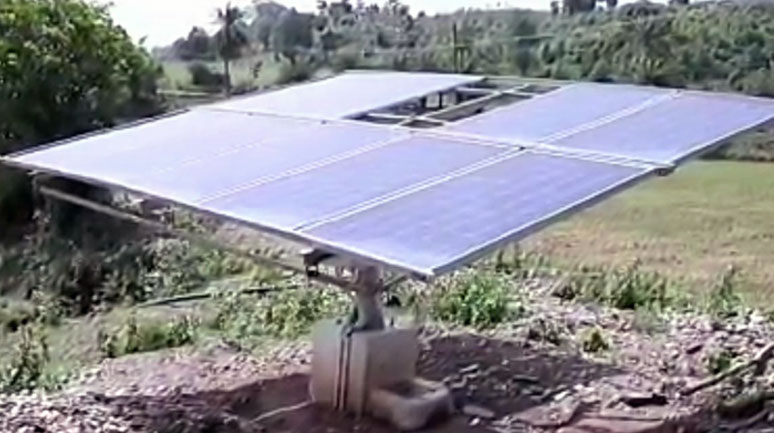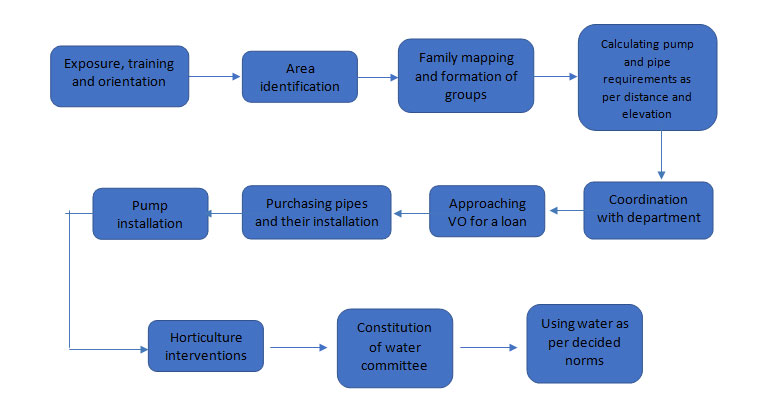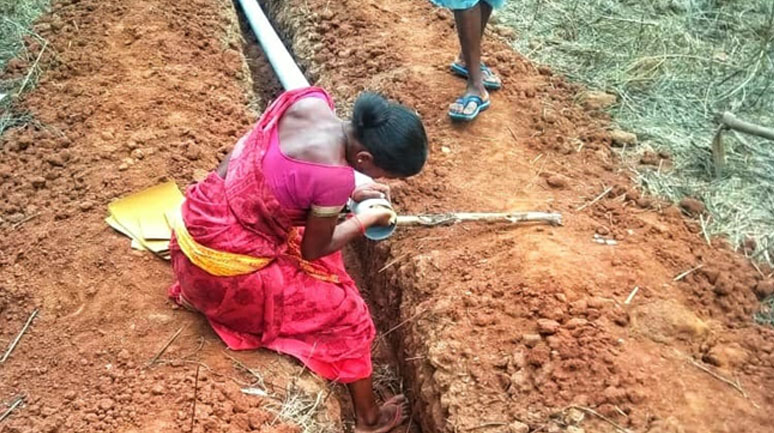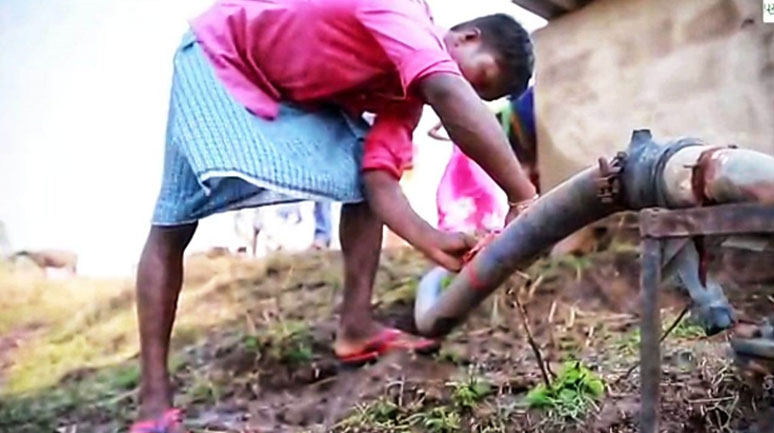Swadesh in Bastar: How Lift Irrigation Changed Lives in Kelaur Village


Recognizing the importance of having a perennial source of water when planning any agricultural activity and change, the SHG women of Kelaur, supported by PRADAN and government departments, installed solar energy-powered water pumps, leading them to cultivating vegetables and fruit in their homesteads, which brought about a sea change in their economic status and self-sufficiency
A griculture in Central India is dominated by paddy cultivation with a large section of farmers only engaging in kharif agriculture. The same village, post-kharif season is filled with uncertainty, and very few households engage in profitable agriculture in the rabi and summer seasons. Some of the reasons behind this are traditional; yet, this is mainly due to the rocky terrain and undulating lands, leading to non-availability of water for crops. In Kelaur, the didis of the Self-Help Groups (SHGs) have found a new direction and have started reaping the benefits of their hard work. This article documents the efforts of the community, the civil society organisations and the government department, which led to this transformation in Kelaur.
Kelaur Village and Its Conditions
Parwati, a tribal woman from Kelaur gram panchayat (GP), wonders if borrowing food from neighbouring households is a permanent solution to her and her family’s troubles. She has been managing her household needs with the income from working in the fields and by selling rice and livestock as per needs. Like other families in the village, she and her husband have many different sources of income, for example, she works as a shepherd sometimes and her husband works as labour in construction and in the fields. This, however, is not a permanent solution for the sense of insecurity, which she experiences each year post-kharif when water levels go down and there are few options to work in the villages. With weary eyes she shares that this is the case with almost all the families and this insecurity has become a permanent part of their lives and they certainly believed that this will never change.
Kelaur is one of the 46 Gram Panchayats (GPs) under Darbha block of Bastar district. It has 321 households and is home to the Bison Horn Maria tribes, only present in Madhya Pradesh (MP) and Chhattisgarh (CG). This ethnic group speaks the Gondi language and usually resides in sparsely located villages on top of hills, in rocky terrains, away from hustle and bustle of towns and cities. They are notified as Schedule Tribes (STs) in the Constitution. Agriculture is the primary livelihood for the village residents. With time, more and more households are migrating to Andhra Pradesh and Telangana for labour work. There are many cases in which those who migrated for work have returned sick and without their payment. One of the reasons for this is that most of these young boys and girls have only had primary education and have had very little exposure to the outside world, thus making them more vulnerable to exploitation. A few people have mortgaged and sold their assets, including part of their agricultural land, for survival.
Small Steps Leading to Big Changes
I n 2016, 22 women from Kelaur, including Parwati, formed two SHGs—Kaner Phool and Gangadey—with support from PRADAN, a civil society organization (CSO) working in the region since 2009. SHGs are formed at the local level by collectivizing women from same socio-economic backgrounds to build a support system within the villages and which gradually moves towards finding collective solutions. During the many meetings, the lack of livelihood opportunities within the village came up as one of the major obstacles for almost all the SHG members. Because most of the families are acquainted with farming, it was decided to strengthen agriculture instead of exploring other options for income generation. A major impediment to agriculture was the absence of any irrigation facility in the villages. Thus, the group started brainstorming about ways by which water could be brought to their homestead lands for irrigation.
PRADAN’s Experience of Lift Irrigation
P RADAN has been working in rural areas since 1983 and has successfully installed lift-irrigation systems in many villages in Gumla and West Singhbhum. These are functional even after 15 years of installation. These lift-irrigation models, which primarily ran on diesel, allowed communities to begin vegetable cultivation in their homesteads and on unused fallow land. Another reason for the success and sustenance of this intervention is that there is always need for vegetables in nearby villages and, hence, there is constant demand for it. In addition, PRADAN ensured that the community was involved from the beginning of the planning activities; thus, the main ownership for it was of the community and not of the other stakeholders.
The experience of PRADAN in Jharkhand also validates that communities will engage in agricultural activities for the entire year if water is available for the fields, leading to additional source of income for the families and also increased nutritional diversity in the food intake of families.
PRADAN has been working in rural areas since 1983 and has successfully installed lift-irrigation systems in many villages in Gumla and West Singhbhum. These are functional even after 15 years of installation.
Replicating the Idea in Bastar with Solar Energy
I n Bastar, the additional challenge is the lack of continuous supply of electricity in the villages, which is crucial for the pumps to lift water. The high electricity bills and the maintenance of the pump were big challenges. Diesel pumps were not an option because the community could not bear the recurring and high cost of diesel required to run the pumps. During discussions in the community, the use of solar energy came up as a viable option for lifting water from the stream. It has low maintenance costs and no recurring monthly electricity bills. SHG members were taken for an ‘exposure visit’ to Jharkhand, to understand the benefits of lift-irrigation-based vegetable farming. In addition, the SHG members were oriented by PRADAN staff, through videos, on the process to be adopted. These efforts were fruitful and motivated the SHG members to try it in their own villages. During that time, the government announced the Saur Sujala scheme, in which the Chhattisgarh Renewable Energy Development Agency (CREDA) offers full subsidies on solar pumps and solar plates. The only financial implication involved was the processing fee of Rs 10,000, which would be borne by the community.
With support from CREDA and technical inputs from PRADAN, the SHG members installed a solar pump-driven, lift-irrigation system to pump water from a nearby perennial pond to their homestead lands. Small and medium farmers of CG, who wanted to install solar pumps, were eligible for this subsidy under this scheme.
The solar energy system was sanctioned on an individual’s name, and an agreement was arrived at that the solar base pump could be utilized by all members. In lift-water irrigation, the pump is the costliest and the primary equipment, and additional money is needed for the installation of pipes. The pump costs around Rs 2 to 3 lakhs, depending on its horsepower; the cost of the pipes is dependent on the distance between the fields and the source.
In Kelaur, the pump was covered under the Saur Sujala scheme, and Rs 60,000 for the pipes and the installation was taken as a loan from the Village Organization (VO) formed under the National Rural Livelihood Mission (NRLM) and PRADAN. Fourteen SHGs are part of this VO, the main objectives of which are strengthening the livelihoods of vulnerable and deprived households and helping members financially and socially. Norms were articulated for taking loans from the VO; all the SHGs registered under the VO were eligible for this support. One of the important conditions is that this loan money has to be used only for strengthening livelihoods.
Solar-powered Lift Irrigation


Underground pipe laying for lift irrigation (PC- Raju Kumar)
Management of the Solar Pump
P roper management of the installed lift-irrigation system is important for the intervention to be successful in the long run. Hence, a water committee, comprising all the families using the water, was formed. During SHG meetings, Rs 40 per month rent is collected from each of household. A separate cash book is maintained by the SHG accountant for this and the money is used for the maintenance of the pump and pipes, and for providing wages to the pump operator. The pump operator is responsible for ensuring that water reaches each homestead land and for taking care of the solar pump system.
| S.No | Activity | unit | Quantity | Cost |
|---|---|---|---|---|
| 1 | Pit digging (600 m) for pipe line | Labour days (Rs 176) | 100 | 17,600 |
| 2 | PVC pipes and accessories | Number | 100 | 70,000 |
| 3 | Transportation | One time | 1 | 4,000 |
| 4 | Pipe fitting charges | One time | 1 | 2,000 |
| 5 | Solar system 3HP ( with subsidy) | Number | 1 | 10,000 |
| 6 | Labour charged | Labour days (Rs 176) | 30 | 5,280 |
| Total Cost | 1,08,880 |
Intervention Outcomes
S ince the installation of the lift-irrigation facility on their homestead lands in 2017, 22 households in Kelaur have been cultivating three crops a year. This is a significant change, and families now earn an additional net income of Rs 15,000 to 20,000 by the sale of vegetables and mangoes from their homestead land. Previously, they earned only Rs 1,000 to 2,000 during the kharif season.
This income has become even more crucial in times of COVID 19 when the entire economy is under stress and everyone is unsure of their future. These households have been able to manage their household expenses by selling vegetables in the nearby local markets. Thus, their situation is much better than other households.
Parwati, who is irrigating her land through the solar lift expresses her joy by saying, “Now, we are earning money and are also able to pay for the books, uniforms and education of our children. Earlier, my house was not in a good condition; now I have reconstructed it.” Parwati and her husband have got enough work on their land, tending to the mango plants and pulses and vegetables through the year.
This model ensured that community and government departments come together and work for a common objective. In the process adopted, both departments and the SHG members engaged in and contributed to a common goal. This makes the interventions more sustainable.
Challenges Faced
L ike any other intervention, these interventions have their share of challenges. The open grazing of livestock by local communities is one of the biggest challenges to the standing crops within the homestead. However, with better fencing arrangements instead of the current stone fencing, this challenge can be overcome. This leads to another major challenge—the capital-intensive nature of this intervention. In a situation in which people are not able to earn a decent livelihood, it is difficult to expect large, initial investments from them for installing the lift irrigation. However, people can leverage existing government schemes, which support solar pump installation and lift irrigation.
What Makes This Model Sustainable and Replicable?
T his model ensured that community and government departments come together and work for a common objective. In the process adopted, both departments and the SHG members engaged in and contributed to a common goal. This makes the interventions more sustainable. And the joint efforts of the departments made sure that the cost borne by the community members was very low. The horticulture and agriculture departments and CREDA ensured that technical inputs are received on a regular basis. PRADAN played a critical role in bringing various stakeholders together. The simplicity of the model makes it replicable and sustainable for all the areas where there is a perennial source of water and there is need for water near the village settlements.
Recently, during a visit, Mr. J.N. Baiga (Executive Engineer, CREDA, Bastar) said after a field visit, “This is a very low-cost model, which requires very little maintenance. This is the for the first time that I see how collectives can play a big role. Here, one system is supporting 12 families and can irrigate 10 acres of land without any problem. Community ownership is very important for long-term sustainability. We are planning to use the same model for all districts.”

Jai Nag, village youth is trained to maintain the solar system. He is the care taker and pum operator. (PC: Raju Kumar)
Way Ahead
T he enhanced income of these 22 households from Kelaur has inspired people of several other villages, blocks and districts within CG. Currently, lift-irrigation installation work in 28 hamlets of 16 villages is under progress and 12 are soon to be started. By the end of 2020, approximately 600 families are planning to cultivate at least two crops in their homestead lands to earn more from agriculture. After seeing the village’s irrigation facility, the district administration has sanctioned 18,000 grafted mango saplings to be planted in their homesteads under MGNREGA.
With a growing number of households cultivating vegetable crops on their homestead lands using lift-irrigation, having market linkages have emerged as yet another challenge. PRADAN is now working with the local communities to facilitate the aggregation of the crop produce and to link farmers to the market and is hopeful of finding solutions with the didis.


8 Comments
Great initiative. year long supply of water is the back bone of agriculture and in the high areas of bastar and other parts of india its a challenge. Agriculture sector have the potential to recover families and Indian economy from bad times of covid 19
Well said Sandeep. Irrigation facilities for this area is just like a boon. trible people are very happy after seeing this . Dreams comes true…
Great Bhai …keep it up
Thanks
Raju Kumar one of the few human beings that he always willing to face all kinds of problems and providing betterment to needy place.. he is positive self motivated person, if i not say wrong he is the example of self reliance candidates…… I wish to God to full fill all his beautiful dream….. may God bless him.
Thanks a lot for such kind of appreciation…
The direction in which you are working is truly commendable. May God inspire you for your good works so that agriculture can be developed in these tribal areas and the villagers can become self-dependent..
Thank you
The direction in which you are working is truly commendable. May God inspire you for your good works so that agriculture can be developed in these tribal areas and the villagers can become self-sufficient.
Thank you